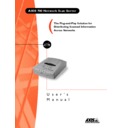Sharp AR-AX1 (serv.man2) User Manual / Operation Manual ▷ View online
AXIS 700
User’s Manual
Section 3: Configuring the AXIS 700
33
Specifying Destinations
Destinations are used when sending scanned images from the AXIS
700 control panel. A destination can be an e-mail address or a file on
an FTP server.
700 control panel. A destination can be an e-mail address or a file on
an FTP server.
1. From within the Administration pages, click Destinations.
2. The previously added e-mail and file destinations are listed in the
table. Click Detail to view the detailed settings.
3. Click the Destination Name link to edit a destination in the list.
4. If you permit users to add temporary e-mail destinations, the five
most recently added ones will appear at the top of the table. You can
make these temporary destinations permanent by clicking Make
Permanent
make these temporary destinations permanent by clicking Make
Permanent
.
5. To change the default settings for destinations, e.g. the default
scanning profile, click Destination Defaults.
6. To delete all destinations, click Remove All Destinations.
Note:
The Destination Name is the text that will appear in the
destination list on the AXIS 700 control panel.
Section 3: Configuring the AXIS 700
AXIS 700 User’s Manual
34
E-mail Destinations
E-mail destinations
allow the users to send scanned images to
e-mail addresses using the SMTP protocol.
1. Click New E-mail Destination to define a new e-mail
destination.
The e-mail can include the scanned image as:
• an e-mail attachment, or
• a hyperlink (URL) to the original file
• a hyperlink (URL) to the original file
2. If you are using e-mail URLs
, you must specify the location for
storing the scanned images. Click URL for E-mail to specify the
directory where all such images will be stored.
directory where all such images will be stored.
Note:
You can enter more than one e-mail destination. Separate the
different entries with comma (,) or semi colon (;), e.g.
user1@company.com, user2@company.com
user1@company.com, user2@company.com
You can also include a list of external e-mail addresses. See
“External Address Book ”on page 32.
File Destinations
File destinations
allow the users to store scanned images in a
directory on a file server using the FTP protocol.
Click New File Destination to define a new file destination.
AXIS 700
User’s Manual
Section 3: Configuring the AXIS 700
35
The file name can be adjusted to your specific needs:
•
If you have a series of image files, you can append a unique
sequence number to the file name. A new image file will then be
stored each time someone scans to the specified destination.
For example, if you select
sequence number to the file name. A new image file will then be
stored each time someone scans to the specified destination.
For example, if you select
01
as the sequence number from the
drop-down list, the first time you scan an image to the specified
destination, the file will be saved as
destination, the file will be saved as
filename01
. Next time the
file will be saved as
filename02
etc.
For a directory with many files, performance will increase if you
store the sequence number on the FTP server. However, to do
that, the AXIS 700 must be permitted to overwrite/delete files in
the specified directory.
store the sequence number on the FTP server. However, to do
that, the AXIS 700 must be permitted to overwrite/delete files in
the specified directory.
•
You can add the file extension to the file name, i.e.
tif
,
jpg
, or
pdf
. The file extension is needed for automatically launching the
appropriate image viewer.
Section 3: Configuring the AXIS 700
AXIS 700 User’s Manual
36
Specifying System Settings
Click This AXIS 700 to display general system information.
From this page, you can click:
•
Edit to change any of the system settings
•
View Settings to list the current configuration settings
•
Restart Server to perform a restart
•
Factory Defaults to restore the factory default settings
Server Password
You are recommended to set a Server password to protect the system
settings. For example, you will be prompted for the password when
logging in for administration via HTTP and FTP.
settings. For example, you will be prompted for the password when
logging in for administration via HTTP and FTP.
Note:
If you lose the Server password, you must restore the factory
default settings. See “Restoring Factory Default Settings ”on page
55.
55.
Time Synchronization
To obtain date and time information from a time synchronization
source, specify an NTP server. Time stamps are used in the event log.
source, specify an NTP server. Time stamps are used in the event log.
Click on the first or last page to see other AR-AX1 (serv.man2) service manuals if exist.

